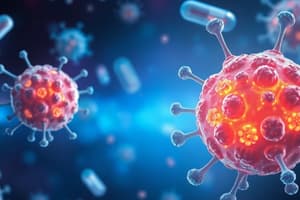Podcast
Questions and Answers
What is the primary target of antibiotics?
What is the primary target of antibiotics?
- Parasites
- Viruses
- Bacteria (correct)
- Fungi
What is antimicrobial resistance?
What is antimicrobial resistance?
- A phenomenon where microorganisms evolve to survive despite exposure to antimicrobial agents (correct)
- The ability of microorganisms to eliminate all antimicrobial agents
- The complete elimination of all microorganisms from an environment
- The process of creating new antimicrobial agents in a lab
Which of the following is NOT a type of antimicrobial agent mentioned in the text?
Which of the following is NOT a type of antimicrobial agent mentioned in the text?
- Antiviral drugs
- Antibiotics
- Antifungal agents
- Antiparasitic agents (correct)
Why has the widespread use of antibiotics raised concerns?
Why has the widespread use of antibiotics raised concerns?
What type of infections do antifungal agents primarily treat?
What type of infections do antifungal agents primarily treat?
What is the main challenge posed by antimicrobial resistance?
What is the main challenge posed by antimicrobial resistance?
What is the mechanism of action of azoles, such as fluconazole and itraconazole, in inhibiting fungal growth?
What is the mechanism of action of azoles, such as fluconazole and itraconazole, in inhibiting fungal growth?
Which antifungal drug binds to ergosterol in the fungal cell membrane and creates pores, leading to cell death?
Which antifungal drug binds to ergosterol in the fungal cell membrane and creates pores, leading to cell death?
What is the purpose of antimicrobial stewardship programs?
What is the purpose of antimicrobial stewardship programs?
What is the major difference between antiviral drugs and antifungal drugs?
What is the major difference between antiviral drugs and antifungal drugs?
What is the role of echinocandins like caspofungin and micafungin in inhibiting fungal growth?
What is the role of echinocandins like caspofungin and micafungin in inhibiting fungal growth?
What is the primary aim of antimicrobial stewardship programs regarding antimicrobial resistance?
What is the primary aim of antimicrobial stewardship programs regarding antimicrobial resistance?
Flashcards are hidden until you start studying
Study Notes
Antimicrobial Agents: Fighting Infection and Tackling Resistance
Antimicrobial agents are substances that can eliminate or inhibit the growth of microorganisms, including bacteria, fungi, viruses, and parasites. They play a crucial role in modern medicine, enabling us to treat infections and improve overall health. In this article, we'll explore the various types of antimicrobial agents, their significance, and the challenges posed by antimicrobial resistance.
Antibiotics
Antibiotics are the most well-known antimicrobial agents, targeting bacteria. These substances, typically derived from microorganisms or synthesized in a lab, disrupt bacterial cell structures or functions, thereby preventing bacterial growth or even inducing bacterial cell death. Examples of antibiotics include penicillin, tetracycline, and erythromycin.
Antimicrobial Resistance
Unfortunately, the widespread use of antibiotics has led to the development of antimicrobial resistance, a phenomenon where microorganisms evolve to survive and thrive despite exposure to antimicrobial agents. This resistance can occur through genetic mutations, gene transfer, and other mechanisms. As a result, once-effective treatments become less effective or completely ineffective, posing a significant threat to public health.
Antifungal Agents
Fungi require antimicrobial agents of their own, known as antifungal agents. These substances are used to treat fungal infections, which can affect both humans and plants. Examples of antifungal drugs include azoles, echinocandins, and polyenes. Azoles, like fluconazole and itraconazole, inhibit the synthesis of ergosterol, a critical component of fungal cell membranes. Echinocandins, such as caspofungin and micafungin, block the synthesis of β-glucan, an essential component of fungal cell walls. Polyenes, like amphotericin B, bind to ergosterol in the fungal cell membrane and create pores, leading to cell death.
Antiviral Drugs
While bacteria and fungi are eukaryotic organisms, viruses are acellular pathogens with a much more complex relationship with antimicrobial agents. Antiviral drugs target viruses in different ways, including inhibiting viral replication, preventing viral attachment or entry into cells, and enhancing the host immune response. Examples of antiviral drugs include acyclovir for herpes, oseltamivir for influenza, and remdesivir for COVID-19.
Antimicrobial Stewardship
To combat antimicrobial resistance, antimicrobial stewardship programs have been established. These initiatives aim to optimize the use of antimicrobial agents, ensuring that they are prescribed appropriately, and reserved for cases where they are most effective. Antimicrobial stewardship programs focus on promoting the right drug for the right patient, at the right dose, for the right duration, and via the right route. These programs help to prevent the emergence and spread of antimicrobial resistance, thus preserving the effectiveness of our current antimicrobial agents and enabling us to develop new ones.
In conclusion, antimicrobial agents are a vital tool in modern medicine, enabling us to treat infections and improve overall health. However, the development of antimicrobial resistance poses a significant threat to public health. Understanding the various types of antimicrobial agents and their applications, as well as the strategies employed to combat antimicrobial resistance, is essential in ensuring the long-term effectiveness of these agents in the fight against infection.
Studying That Suits You
Use AI to generate personalized quizzes and flashcards to suit your learning preferences.




